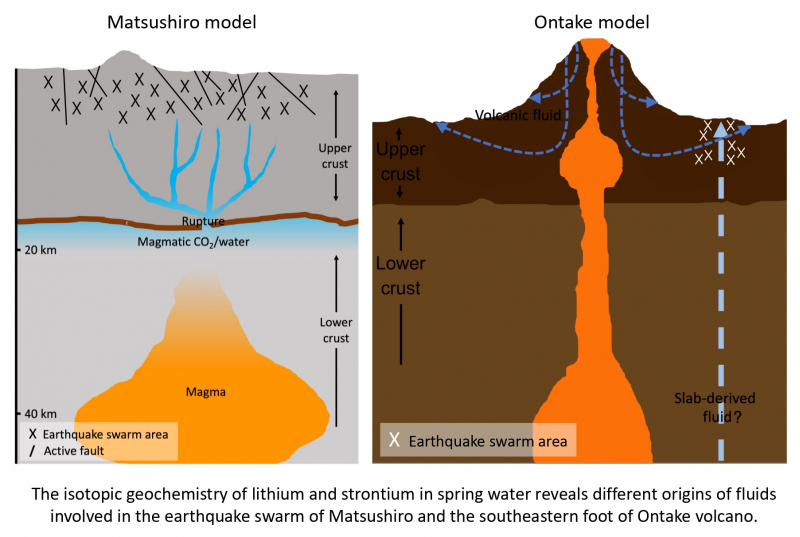
Origin of spring waters in the Matsushiro area: Implications for the 1965–1967 earthquake swarm and subsequent “water eruption”
ABSTRACT

The Matsushiro earthquake swarm, which unusually persisted from 1965 to 1967, generated a gush of groundwater at the end of the period so massive that it was referred to as a “water eruption”. In this study, we analyze the geochemistry of Matsushiro spring waters collected in 2009 and 2010, with a focus on Li and Sr isotopic ratios. The Li and Sr isotopic ratios of Matsushiro spring waters, excluding the samples most contaminated by surface-water influence, were +4.0‰ to +6.0‰ for δ7Li and 0.7044–0.7045 for 87Sr/86Sr. These isotopic ratios are similar to those of Matsushiro igneous rocks (δ7Li –1.2‰ to 5.4‰, 87Sr/86Sr 0.7043–0.7050), supporting the hypothesis that the Matsushiro deep-derived fluid has a magmatic origin. Based on our results, the δ7Li value of Matsushiro deep-derived fluid without contamination by surface water is estimated to be +4.2‰. Using a Li isotope geothermometer, we estimate that the fluid–rock reaction temperature between the Matsushiro deep-derived fluid and magma exceeded 700°C. Furthermore, the insights obtained from this study on Matsushiro spring waters, emphasizing the characteristics of magma-derived fluid in central Japan, provide valuable information for distinguishing the origin of previously ambiguous fluid associated with the earthquake swarm at the southeastern foot of Ontake volcano, central Japan.
KEYWORDS
Keywords: lithium isotope, geothermometer, Matsushiro earthquake swarm, geofluids- Published : 2024
- Released on J-STAGE : 2024/09/14
- Received : 2024/02/28
- Accepted : 2024/07/14
- DOI : https://doi.org/10.2343/geochemj.GJ24015
- J-STAGE URL : https://www.jstage.jst.go.jp/article/geochemj/58/5/58_GJ24015/_article/-char/en
- J-Online ISSN: 1880-5973
- Print ISSN : 0016-7002
- ISSN-L : 0016-7002
All Issues
- Vol.59, 2025
- Vol.58, 2024
- Vol.57, 2023
- Vol.56, 2022
- Vol.55, 2021
- Vol.54, 2020
- Vol.53, 2019
- Vol.52, 2018
- Vol.51, 2017
- Vol.50, 2016
- Vol.49, 2015
- Vol.48, 2014
- Vol.47, 2013
- Vol.46, 2012
- Vol.45, 2011
- Vol.44, 2010
- Vol.43, 2009
- Vol.42, 2008
- Vol.41, 2007
- Vol.40, 2006
- Vol.39, 2005
- Vol.38, 2004
- Vol.37, 2003
- Vol.36, 2002
- Vol.35, 2001
- Vol.34, 2000
- Vol.33, 1999
- Vol.32, 1998
- Vol.31, 1997
- Vol.30, 1996
- Vol.29, 1995
- Vol.28, 1994
- Vol.27, 1993
- Vol.26, 1992
- Vol.25, 1991
- Vol.24, 1990
- Vol.23, 1989
- Vol.22, 1988
- Vol.21, 1987
- Vol.20, 1986
- Vol.19, 1985-1986
- Vol.18, 1984
- Vol.17, 1983
- Vol.16, 1982
- Vol.15, 1981
- Vol.14, 1980
- Vol.13, 1979
- Vol.12, 1978
- Vol.11, 1977
- Vol.10, 1976
- Vol.9, 1975
- Vol.8, 1974
- Vol.7, 1973
- Vol.6, 1972-1973
- Vol.5, 1971
- Vol.4, 1970-1971
- Vol.3, 1969-1970
- Vol.2, 1968
- Vol.1, 1966-1967




